
This Article From Issue
March-April 2002
Volume 90, Number 2
DOI: 10.1511/2002.10.0
Secret Knowledge: Rediscovering the Lost Techniques of the Old Masters. David Hockney. 296 pp. Viking Press, 2001. $60.
Vermeer's Camera: Uncovering the Truth behind the Masterpieces. Philip Steadman. xiv + 207 pp. Oxford University Press, 2001. $25.
David Hockney, a British painter who has spent much of his artistic life in Southern California, lays out and defends a series of bold conjectures in Secret Knowledge. The story begins when he visits an exhibit of paintings and drawings by Jean-Auguste-Dominique Ingres at the National Gallery in London in 1999. At the exhibit, Hockney is struck, in particular, by the pen-and-ink drawings and, most specifically, by the portraits, which were produced around 1816. What catches his painter's eye is that, relative to their "unnaturally small" size (they are often no larger than 12 by 8 inches) they seem incredibly detailed and "uncannily 'accurate.'" In art history circles, Ingres has often been praised for his talent as a draftsman, but Hockney, who knows from his own experience as a portrait painter how hard it is to produce such detail, suspects that something else might be at work.
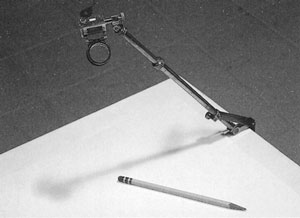
From Secret Knowledge.
Hockney purchases the catalogue from the show, photocopies the drawings and tacks them up on the wall of his studio in California for a closer look. In the pen-and-ink markings Ingres had made early in the 19th century, Hockney believes he can detect Andy Warhol's line. He knows that Warhol used a slide projector to project photographs from which he traced his images, and Hockney is convinced Ingres must have used a similar device. He puts a 1975 Warhol drawing and an 1816 Ingres drawing side by side and becomes even more convinced.
But if Ingres made use of a similar device, what was it? Photography was not invented until 1839; Warhol's projection technique would not have been available to Ingres in 1816. The camera lucida, however, was invented in 1806, and Hockney conjectures that Ingres must have used just such an optical device to do his portraits. It consists of a prism at the end of a metal rod, which extends from a weighted stand or clamp that can be placed on a table over a sheet of drawing paper. The artist looks through the prism and is able to see the image of the subject seated before him on the paper, which he can then trace.
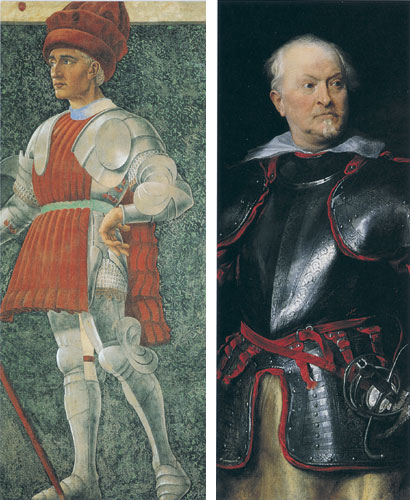
Hockney sends his assistant on a tour of the antique shops in Los Angeles to find and purchase a camera lucida. He then settles down to recreate Ingres's working conditions, drawing a series of line portraits of his own with its aid. Secret Knowledge includes 18 portraits executed over the period of nearly a year, which clearly demonstrate Hockney's growing mastery of the instrument.
The encounter with Ingres's work becomes the catalyst for a much broader thesis, developed by Hockney over the next two years: that before the advent of photography, many Western artists used optics, including lenses and mirrors, to create projections from which they made their pictures.
Hockney calls what he sees in the Ingres portraits "the optical look." He sets off on the trail of this optical look in other paintings from other periods and different parts of Europe. He hauls a photocopier into his studio and begins to put copies of pictures that seem to his eye to harbor this look on the wall of his studio. Soon the wall (70 feet long and 2 stories high) is filled with reproductions of works—by Jan van Eyck, Leonardo da Vinci, Albrecht Dürer, Hans Holbein the Younger, Michelangelo Merisi da Caravaggio, Diego Velázquez, Johannes Vermeer, Jean-Baptiste-Siméon Chardin and others—dating from 1300 to the 1830s.
Hockney singles out those paintings that, to be rendered convincingly, require a sensitivity to shadow and light and minute detail. He notices that clothing worn by a figure in a painting made by Giotto between 1303 and 1306 is "done in a simple graphic way," whereas Giovanni Battista Moroni in 1553 "is painting the most elaborate of dresses with a bold design that is always believable on its surface, following the folds, and with subtle highlights and shadows all depicted."
A visual survey of the portrayal of suits of armor reveals a similar shift: A painting by Andrea del Castagno in 1448 seems awkward and dull compared with a depiction by Giorgione (Giorgio da Castelfranco) in 1501 and one done by Anthony van Dyck between 1625 and 1627, in which one can see the play of reflected light on the shiny metal. Hockney comments that in the van Dyck "the armour looks almost like a photograph." About these changes over two centuries he wonders: "Have we got a new tool at work here?" He examines depictions of lutes, necklaces, brocade, maps, tapestries and carpets over this same period and finds in each instance a sudden ability to render the image perfectly.
How could this change have happened so suddenly, over such a brief period of time? Dismissing "better drawing skills" as a possible answer, he is sure that some sort of lens-assisted technology must have become available to artists during the 16th century, if not earlier.
Hockney's thesis rests, at least initially, almost exclusively on features of the paintings themselves. And this has, unsurprisingly, caused some controversy. It can appear as though Hockney is doing little more than noticing the fidelity of a rendering and concluding that optics must be involved in some way. The appearance of a rush to judgment has been a source of alarm among a number of art historians and optical scientists. Where is the hard proof, they wonder; where is the documentary evidence?
In one respect, however, lack of evidence is a point in Hockney's favor. For many of the paintings in which he detects an optical look—those by Velázquez, Chardin, Caravaggio and Vermeer, for example—there are no preparatory drawings or preliminary sketches. Their absence suggests a boldness on the part of the artist, a willingness to apply the image directly to the canvas that reliance on an optical device or some sort of "projection" system would help to explain.
At a recent conference on Hockney's theories, Gary Tinterow, a senior curator at the Metropolitan Museum and an Ingres scholar, confessed to an ambivalence about Hockney's claims. On the one hand, he noted, Ingres's drawing style did undergo a noticeable shift after 1807, when the camera lucida would have been available to him. On the other hand, Ingres might, in fact, be quoting from earlier sources. Of course, those earlier sources could have been using lenses to produce their own paintings. Regarding the smallness of the drawings, Tinterow noted that Ingres's father was also a painter and a miniaturist. Tinterow ended on a plaintive note: "It would be nice if we could find an account from one of Ingres's sitters—and there are many who left such accounts, who mention his easels and brushes and canvases—a sitter who described Ingres's use of such optical devices."
The first part of Secret Knowledge, the bulk of the book, takes the reader through Hockney's thought process and contains much of the visual evidence for his thesis: 460 stunning illustrations, 402 of them in color. Images are often juxtaposed to allow comparative study. The second part of the book collects a number of documents that serve to support Hockney's points. The third reproduces much of Hockney's correspondence about his research with friends, art historians and scientists—in particular, Charles Falco, a professor of optical sciences and chair of condensed-matter physics at the University of Arizona, who became a collaborator and fellow enthusiast in the middle stages of Hockney's explorations.
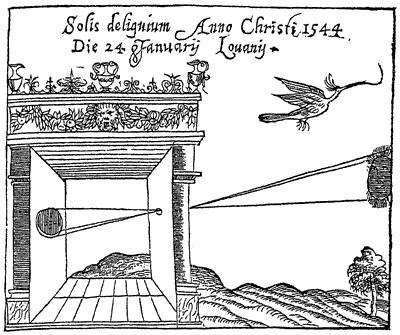
From Secret Knowledge.
Since publication of the book, some critics have complained that even in cases in which there is some truth to a claim, what Hockney says is nothing new. Hockney admits that others have noticed that painters have made use of optical devices as an aid to their picture-making. But Hockney is alone in insisting that optical devices were used so widely and by so many artists. In addition, stimulated by Falco's passing remark that concave mirrors can "project" an image, Hockney has come to believe that painters were using such mirrors as projection devices from as early as 1430 until the 1550s and 1560s, when the lens-based technology of the camera obscura came into vogue. That claim is not only startlingly "new" but worthy of further systematic investigation.
In this regard, Vermeer (1632–75), who was painting a century after the "break" between the use of mirrors and lenses in Hockney's rewriting of Western art history, is a most interesting case—in part because the visual evidence is so strong, despite the absence of documentary evidence.
Art historians, such as Lawrence Gowing and more recently Svetlana Alpers, have noticed qualities in Vermeer's works that might have arisen from the use of some sort of projected imagery, noting that there is apparently little underlying "drawing" in the Vermeers; it is as if he were just transcribing the alternating patterns of shadow and light. Others have noticed that in the course of enlarging the surface of a Vermeer, the highlights on reflective surfaces such as polished wood or glass break up into globules of light or halations, a characteristic one associates with a view of the world through a lens.
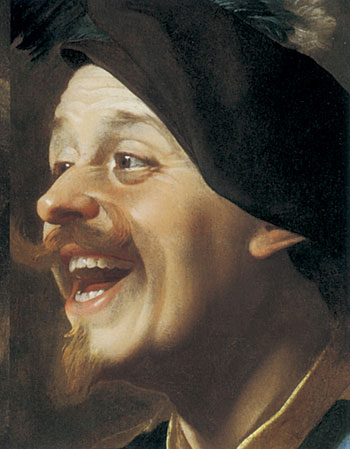
Hockney notes the fidelity in the rendering of objects with complex patterns and minutely detailed design, such as carpets and dresses, as a possible tip-off that some sort of optical device was used; this is supported by what is now known of Vermeer. The astonishing accuracy and precision with which Vermeer rendered the maps hanging on the back walls of several of his interiors has been confirmed by historian of cartography James Welu, who has found surviving examples of all of the globes and maps depicted in Vermeer's paintings.
The camera obscura (literally, "darkened room") was in use in Holland at the time of Vermeer and would have been available to him. An enclosure with a pinhole or lens at one end, it allowed an image of the outside world to be cast upside-down on the darkened wall opposite, over which one might place a bit of tracing paper and sketch the image's outline and shape. We know that several astronomers made use of it in the early part of the 16th century: Both Johannes Kepler and Christopher Scheiner used a camera obscura to study the activity of sunspots. In 1558 in his Magia Naturalis, Giovanni Battista Della Porta stressed that the camera obscura would also be invaluable to draftsmen and artists and described the device in some detail. Of course, much of this evidence is circumstantial, and none of it settles whether Vermeer himself owned a camera obscura, let alone made use of such a device.
Philip Steadman's Vermeer's Camera is, therefore, a welcome addition to the debate, since he tackles the question of Vermeer's use of lens-based technology in a wholly new way. Trained as an architect, Steadman begins by taking careful measure of the Vermeer interiors. Starting with the uncontroversial assumption that many of the interiors seem to portray the same room, he sets about reconstructing the architecture of the space. Assuming that the floor tiles are square and the room rectangular, he is able through a fairly standard geometric procedure (suggested by Leonardo, among others) to establish the relative sizes of various aspects of the room. This procedure does not, however, establish "the absolute scale." As Steadman notes, the pictures "might equally well show dolls in dolls' houses as living people in normal-sized rooms." To obtain a result, Steadman could no doubt have made some reasonably good guesses, taking the average height of the human figures and relying upon what is known about the size of the furniture of the time, but he sought a more exact method.
As already mentioned, the actual dimensions of the maps depicted in the background of several of the paintings are known. Furthermore, Dirck van Baburen's The Procuress, a painting now in the Museum of Fine Arts in Boston, whose dimensions are of course precisely known, can be seen hanging on the wall in two of Vermeer's paintings. The virginals in Vermeer's The Music Lesson are recognizable as instruments created by the firm of Ruckers, and the standard dimensions of their design are used as a cross-check by Steadman for the dimensions of the room as a whole. Also, in The Music Lesson a bit of the rear wall (behind the spot where the "painter" might have stood) is visible in the lower right-hand corner of the mirror hanging over the virginals, and from this information Steadman is able to construct the distance from the front of the room to the back and from one side to the other.
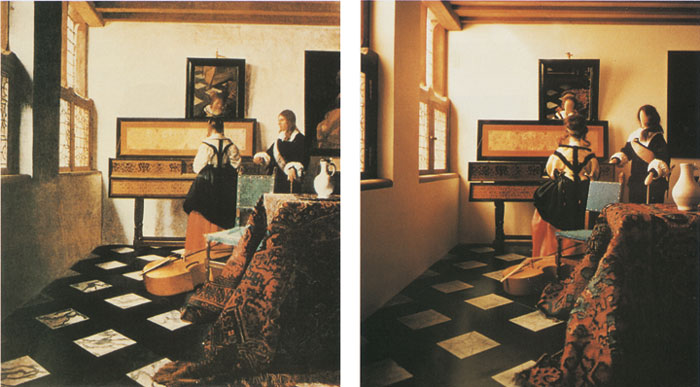
At this stage in his reconstruction project, Steadman discovers what he describes as "an extraordinary geometrical coincidence." If rays are drawn from all points depicted in each painting through the viewpoint and are projected on the back wall of the room, they produce a rectangle. In each of the six cases for which Steadman has recreated the dimensions, "this rectangle is the precise size of the painting in question." Such a result ("extraordinary" indeed) helps to bring home the hypothesis that Vermeer used a camera obscura at the far end of the room.
To test this hypothesis more fully, Steadman constructs a model of the room to a scale of one-sixth of the original dimensions. He also makes props of the furniture and the human figures to the same scale and places them in the space in their appropriate positions. He then has a photographic plate camera fitted into the back of the model room, adjusting the lens to the different viewpoints and keeping its plate on line with the back wall. The camera stands in for the camera obscura. And lo and behold, once photographs are taken and printed out, the lighting in them is very similar to what is seen in the paintings.
Steadman makes six photographic reconstructions of this sort for each of the six paintings for which he has calculated the room dimensions; these confirm with a few minor discrepancies the geometrical findings of the original paintings. Thus Steadman has discovered that in each case "the 'projected images' on the back wall of the room work out at the exact sizes of the paintings themselves." This is impressive. Vermeer's Camera serves to complement and underwrite Hockney's bold thesis in one instance at least, the case of Vermeer.
Hockney has been faulted for jumping to conclusions, but he starts with a hunch. In this respect, his process is not so different from that of a physicist or a chemist at the start of his or her own investigation. In the end it matters little where a hunch comes from. What matters is its testability.
On this note Tinterow, who helped put together the exhibit that got Hockney started, should perhaps have the last word: "Hockney's insights are potentially very important. . . . But it will all depend on fact-finding: Our work . . . is now cut out for us, to find corroborating evidence."
American Scientist Comments and Discussion
To discuss our articles or comment on them, please share them and tag American Scientist on social media platforms. Here are links to our profiles on Twitter, Facebook, and LinkedIn.
If we re-share your post, we will moderate comments/discussion following our comments policy.